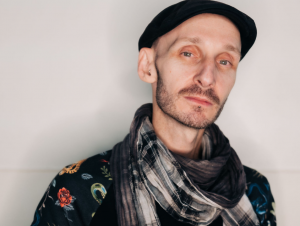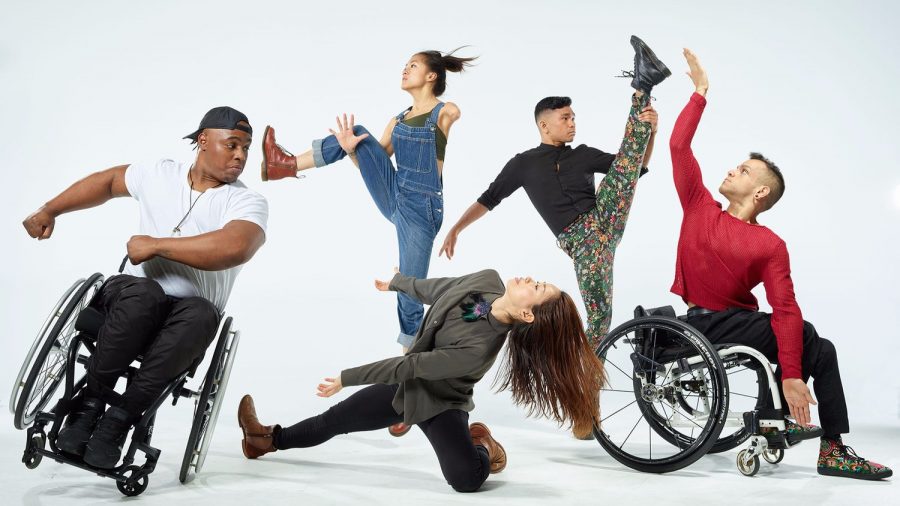AXIS Finds Freedom in Limitations
AXIS 2019 (courtesy of AXIS Dance Company)
November 13, 2019
Stage lights dimly glow on three dancers. The music begins and the art commences — bodies twirl, lift, slide and defy the laws of physics — all with four moving legs, five arms and three dancing souls. This was the beginning of an evening’s performance by AXIS Dance Company at Kingsbury Hall.
AXIS is an integrated dance company equally composed of dancers with physical disabilities and those without. Artistic director and choreographer Marc Brew said, “With artistic expression at the core of what we do, we are raising the bar on physically integrated dance, who can dance and how we create dance.” The company brought this idea with them this past week while in residency here at the University of Utah. Brew and AXIS company members gave lectures and taught dance classes to students in the School of Dance, School of Medicine, Tanner Dance Program and at other local schools. Concluding their stay was an evening concert at Kingsbury Hall on Nov. 8.
Who is Brew?
While speaking to students at the U, Brew shared his personal story of coming to AXIS. He trained in ballet with the Victorian College of the Arts Secondary School and The Australian Ballet School. Later in life, while dancing with Pact Ballet Company in South Africa, Brew got into a severe car accident. This incident paralyzed him from the neck down. “When I became disabled in 1997, I knew dance was still very much a part of who I am,” said Brew. “I just didn’t know what it would look like or how my life and career would unfold after my accident.”
Brew was told he would never dance again. He was living the personification of a dancers’ worst fear, but he didn’t let this challenge keep him from his passion. Over time, Brew began to gain movement in his arms, fingers and the top of the chest. Many of his dance colleagues knew the next step was getting him back into the studio. However, as a paraplegic, ballet classes now meant something different to Brew.

“I had to translate an exact technique,” Brew said. He found different ways to interpret ballet and movement vocabulary. During ballet barre, for example, dancers would practice pliés. This involves the dancers bending at the knees and then straightening back up. In French, the world plié means “to bend,” so Brew began pliéing with his arms or upper back, instead of his legs.
After getting back into dance training, he received new career opportunities, eventually leading to a partnership with AXIS. Brew said, “AXIS has enabled me to become more rounded in [my] artistry.” He grew through the company and has since become the Artistic Director.
Teaching for Tomorrow
AXIS is well-known in the dance community for its Teacher Training Program and their efforts, as Brew said, “to foster tomorrow’s disabled dancers and choreographers.” AXIS trains dance teachers and students to teach classes in the most inclusive and effective ways, encouraging a distinctive vocabulary. For example, during a master class held at the School of Dance, Brew often said phrases like, “Go to a level that is low for you today.” This type of verbiage gave anybody the space to do what was needed within their own personal capacity. “I want to create a space for people to say they have a disability,” Brew said. He believes people need to be cared for in artistic and vulnerable environments.
“AXIS Dance Company is important to me,” said Brew, “because, we collaborate with disabled and non-disabled artists to create virtuosic productions that challenge perceptions of dance and disability.” The use of collaboration is vital for AXIS. Guests artists choreographed all three concert pieces that night in Kingsbury Hall, but none of the sets could have been nearly as memorable without the incredible efforts of the dancers.
The first two pieces were dynamic representations of the moving body. Dancers fully used space, time and energy to perform as a cohesive unit. No matter the physical differences, lines and levels would pair together seamlessly. If one dancer’s leg could reach up high, another’s arm might match. The third and final piece depicted the homeless crisis in Los Angeles using vague connections with the story of “Alice in Wonderland.” Dancers slipped between reality and fairytale and captured the pain and realities of homelessness through their creativity and athleticism. Ultimately, the performance shared the importance of humanity.
The performance was an inspiration and left many audience members deep in thought. Themes of finding joy amid tragedy lingered as Brew shared one final statement with students.“My advice to you is simple — dream and plan, but be prepared for the unexpected,” he said. “Where there is a problem, there is a solution and through restriction, we create possibilities. Keep dancing!”








